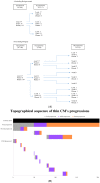Topographical and Chronological Analysis of Thin Cutaneous Melanoma's Progressions: A Multicentric Study
- PMID: 37568805
- PMCID: PMC10416930
- DOI: 10.3390/cancers15153989
Topographical and Chronological Analysis of Thin Cutaneous Melanoma's Progressions: A Multicentric Study
Abstract
A great portion of cutaneous melanoma's diagnoses nowadays is attributed to thin tumors with up to 1 mm in Breslow thickness (hereafter thin CMs), which occasionally metastasize. The objective of this study was to identify thin CM's metastatic patterns from a topographical and chronological standpoint. A total of 204 cases of metastatic thin CMs from five specialized centers were included in the study, and corresponding data were collected (clinical, epidemiological, histopathological information of primary tumor and the number, anatomical site, and time intervals of their progressions). First progressions occurred locally, in regional lymph nodes, and in a distant site in 24%, 15% and 61% of cases, respectively, with a median time to first progression of 3.10 years (IQR: 1.09-5.24). The median elapsed time between the first and second progression and between the second and third progression was 0.82 (IQR: 0.34-1.97) and 0.49 (IQR: 0.21-2.30) years, respectively, while the median survival time was about 4 years since first progression. Furthermore, the sequences of locations and time intervals of the progressions were associated with the clinicopathological and demographic features of the primary tumors along with the features of the preceding progressions. In conclusion, the findings of this study describe the natural history of thin CMs, thus highlighting the necessity to identify subgroups of thin CMs at a higher risk for metastasis and contributing to the optimization of the management and follow-up of thin CM patients.
Keywords: cutaneous melanoma; invasive melanoma; melanoma progressions; metastatic melanoma; metastatic pattern; progression pattern; thin melanoma; thin melanoma metastasis; thin melanoma natural history; thin melanoma progression.
Conflict of interest statement
None of the authors have conflict of interest to declare with respect with this study. Emmanouil Chousakos received a travel grant for this study through the LEO Foundation; however, the sponsor had no role in the design, execution, interpretation, or writing of the study. Aram Boada reports grants from MSD, BMS, GSK, and Pierre Fabre, as well as personal fees from Almirall. Susana Puig and/or Josep Malvehy received honoraria from AMGEN, Bristol, MSD, Novartis, Pierre Fabre, Regeneron, Roche, and Sanofi as speakers or as PIs or as contributors in advisory boards. Sebastian Podlipnik received an honorary from Galenicum Derma in advisory boards.
Figures







References
-
- Gastman B.R., Gerami P., Kurley S.J., Cook R.W., Leachman S., Vetto J.T. Identification of patients at risk of metastasis using a prognostic 31-gene expression profile in subpopulations of melanoma patients with favorable outcomes by standard criteria. J. Am. Acad. Dermatol. 2019;80:149–157.e4. - PubMed

